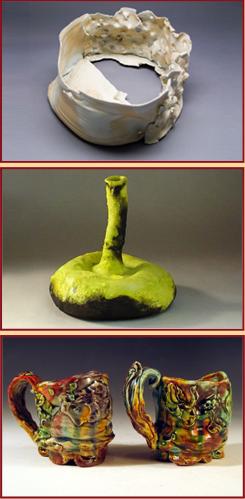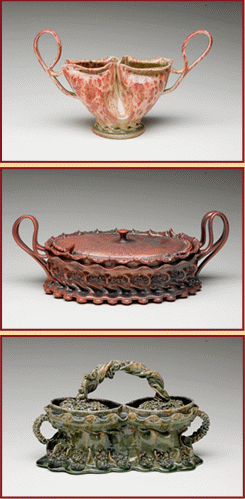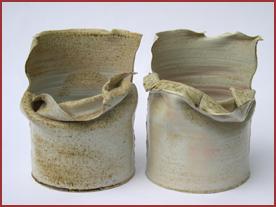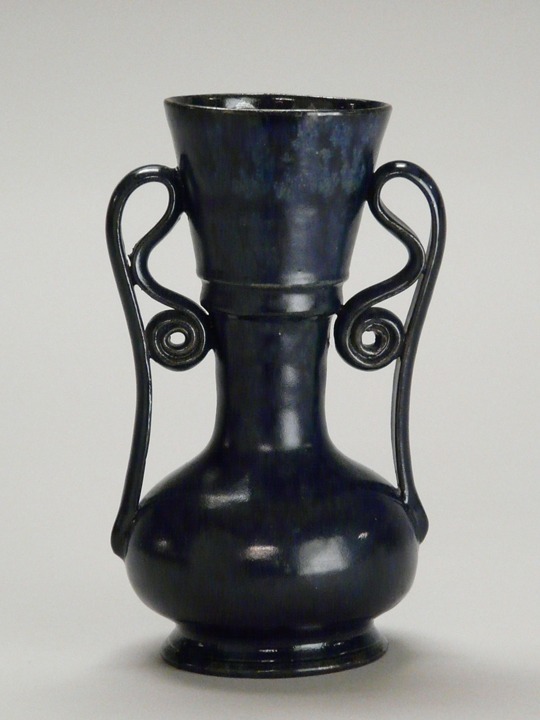

December 8, 2007–February 23, 2008
Organized by the Ohr-O’Keefe Museum of Art, Biloxi, Mississippi
Opening Reception Saturday, December 8, 6-9pm
Ohr Rising: The Emergence of An American Master is an exhibition of 40 key works by art potter George E. Ohr (1857-1918) of Biloxi, Mississippi. In his aesthetic choices, George E. Ohr was a ceramic artist decades ahead of his time. Early on, having mastered the potter’s wheel for production of utilitarian ware and popular souvenir items, Ohr became dissatisfied with the limits of round pots and began to experiment by altering his wheel-thrown shapes. On occasion he used the centrifugal force of his potter’s wheel to cause the pot to twist or buckle. At other times he manipulated the form with his fingers, using folding, indenting, or ruffling techniques to change the contour or rim of the piece.
An important turning point of Ohr’s career was the 1894 destruction of his studio in an all-consuming fire. After construction of his new studio, Ohr seemed more committed than ever to pursuing his novel approach to form. Thin-walled asymmetric shapes, often with elaborate, ribboned handles or ruffled edges became his trademark. The unconventional work was neither well-understood nor well received. Critics denounced Ohr’s work as bizarre or ugly, and with negligible sales his “art” remained virtually unrecognized during his lifetime.
George E. Ohr’s life story holds as many fascinating twists and turns as his pottery. His persona was the epitome of today’s phrase “inventing oneself.” Ohr’s flamboyant physical appearance, his massive mustache, his wild eyes, his outrageous claims of infamy, and his crazy billboard signs earned him the title “The Mad Potter of Biloxi.” Today Ohr’s pieces are highly valued for their inventiveness and are prized as precursors of the 1950’s abstract expressionist attitude toward clay.
The word “Rising” in the exhibition title refers to the “rise from destruction” theme taken on by Mississippi’s Gulf Coast in its valiant recovery effort from Hurricane Katrina in 2005. The Ohr-O’Keefe Museum of Art, which suffered major damage during the storm, is likened to Ohr’s Biloxi studio which was destroyed by fire in 1894. Interestingly, the museum which bears his name has adopted “Ohr Rising” as its mantra for rebuilding, which will begin about the time this exhibit opens.
Curated by Anna Stanfield Harris, a few of the works in the Ohr Rising exhibit are owned by private collectors in Mississippi, but most are from the Ohr-O’Keefe Museum’s permanent collection. Underwriting for the exhibit is provided by grants from the Gulf Coast Community Foundation and the National Endowment for the Arts.
Other Mad Potters
December 8, 2007–February 23, 2008
a corollary exhibition to Ohr Rising: The Emergence of An American Master

Opening Reception: Saturday, December 8, 6-9 pm
Organized by AMOCA, Other Mad Potters is separate exhibit with strong relational ties to Ohr Rising. It features the work of Steve Horn, a Southern California ceramic artist who executes Ohr-like pieces almost better than the master himself. Three other ceramic artists whose creative output connects in some way to the work of George Ohr will also be showcased. Mary Roehm’s work, with its very thin walls and delicate forms, has a certain resemblance to Ohr’s pieces. Lisa Orr’s glazing is evocative of Ohr’s more brightly colored pieces. And Don Pilcher exudes the same freedom of experimentation practiced by Ohr. Pilcher’s “Rascal Ware,” a tale laced with edgy humor, double-entendres, potter’s pseudo wisdom, and references to Ohr, will be presented.
Mary Roehm is known for her gravity-defying, paper-thin vessels made from porcelain and wood fired. Like Ohr, Roehm’s extraordinary skill at the potter’s wheel enables her to create feather-light, nearly translucent forms. In Ohr-like fashion, Roehm exploits the characteristic twisting of thin walled pots, but she goes beyond Ohr, pushing the limits even further by cultivating out-of-round rims with torn edges and by permitting collapse, disintegration, and fracture. Roehm takes a material associated with weight and inflexibility and creates the illusion of flight. “For me, the vessel speaks to the architecture of an object. The inside/outside relationships of space and volume, historically speaking, address utility. The vessel, in particular the bowl form, has a rich history in the craft tradition and provides ample opportunity for investigation and personal interpretation,” Roehm explains. Although not represented in the Ohr Rising exhibit, George Ohr left many of his works unglazed, perhaps to better appreciate the form. Similarly, Roehm leaves the majority of her work unglazed, allowing the fire to work its magic upon the surface of the object.
Don Pilcher’s retirement from the University of Illinois, Urbana-Champaign, where he was a professor of art, has given him the time and freedom to pursue an uncommon approach to ceramics, blending it with story telling. The ceramic ware is genuine, but the story that Pilcher writes, while inspired by his real life, is mostly fiction. He calls it a “biography, twisted through some portal in my imagination….” His tale is about an imaginary pottery where the leading character, Georgette Ore, several other fabricated figures, and Pilcher himself make “Rascal Ware.” The chapters are laced with edgy humor, double-entendres, and potter’s pseudo wisdom. Aside from a certain similarity between George Ohr’s work and “Rascal Ware,” Pilcher’s tall tale makes many references to Ohr. Georgette says that “her family has a legend that there is a connection between the Ores and the Ohrs. The discrepancy in spelling is attributed to the Immigration Service, an alcohol treatment sanitarium, or unregulated voting practices in a large rural county…” Junior, owner of the pottery, is described as “a born-again, fundamentalist, clay-thumping potter. For him, Rascal Ware is a divine calling…where he and George Ohr will sit at the right hand of whomever.”

Including Don Pilcher in Other Mad Potters was based on a number of considerations, most obvious of which is his literary reference to George Ohr in Rascal Tales. Physical similarities–slumped forms, caved structures, manipulated rims, and metallic surfaces–exist between the work of Pilcher and Ohr. The two artists also share parallel principles: the value of experimentation, the importance of original style, and the merit of taking creative risks. Art critic Jason Foumberg describes Pilcher’s work in words that could just as easily describe Ohr’s work: “In Pilcher’s hands, traditional structures are re-invented.…the vessels sometimes have holes or are caving in on themselves and are functionally lost….[Their] subtle beauty can be found in the fate of gravity and fire.” The small size and scale of work made by the then-and-now ceramic artists are in sync, lending preciousness to their vessels.

Observations about the creative process, and the evolution of work
Artist Statement
As a kid, I saw, acted, made objects, drawings, I performed, I was very curious, and I was always going outside the lines/boundaries. I was often in trouble. This strength, bigger than my conscious self knew, directed me. Now I understand this to be the creative process. The creative process is the most fundamental aspect I know and trust about myself. I respect that it isn’t tangible and the more one tries to own it and make it conscious, the more elusive it becomes. It is like breath, an ever-present, unconscious, living activity. There is no formula for developing focus. Mine is a crooked line made up of a hodge-podge of experiences, in the name of being fearless and willing to try anything once (within reason!). While I have experience with success, it is founded on a greater number of failures, believing that only real experience are we able to figure out what we want, what we need and how to pursue our work, whatever that is. Curiosity, experimentation, a willingness to be fearless in the pursuit of excellence, and clarity of expression are fundamental to good art making. My practice is materials-based and responds to the social and anthropological nature of life and culture. As I have grown in experience, the inquiry/research accumulates and the curiosity leads to more critical concerns. The desire to express observations about the nature of repetition underlies the content of my most recent work. There is a meditative quality and rhythm (sometimes interrupted) in the act of punctuating thin porcelain slabs. The process activates the work. The challenge keeps me engaged. As I look forward, I am excited by possibilities. I am grateful and humbled by the power invested through me, and continue to trust this creative process in all aspects of my life.
–Mary Roehm
